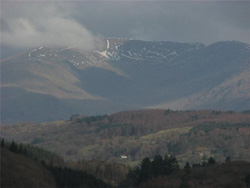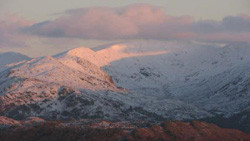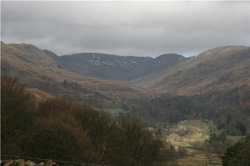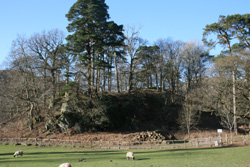
Sir
Roger
de
Lancanster's
deer
park

Fairfield

The
Deer
Park

Site
of
original
Rydal
Hall,
initially
a
hunting
lodge
it
grew
to
become
a
Hall
before
being
moved
to
the
new
site
in
1576
One mile to the north of Ambleside is the hamlet of Rydal, best known as the home of the poet William Wordsworth who lived at Rydal Mount with his family from 1813 till his death in 1850.
The valley stretching away behind Rydal Mount has a history much older than that of the poet, as from about the 13th century it was a deer park used by the Norman rulers for sport.
Deer parks were not uncommon in Lakeland at this time; huge tracts of land being designated as Deer Parks and the rights of the inhabitants within them handed down for generations were severely curtailed.
One of the many other Deer Parks dating from this time was at Troutbeck where about two thousand acres were enclosed in the upper part of the valley.
Rydal first appears in the records in a document dated 3rd May 1277, which tells of a dispute between Sir Roger de Lancaster, lord of the Baronery of Kendal, and William de Lyndesey.
The animals of William’s tenants at Ambleside had strayed into Sir Roger’s hunting preserve at Rydal. A fine was imposed of a half penny for every ox, cow, mare, pig or five sheep caught in the deer park.
A higher rate of one penny was charged for every five goats which probably meant that they created the most damage when let loose in woodland. The park was much more afforested than today but the most interesting item in this medieval dispute is that the two litigants agreed to build a fence around the deer preserve-to define it as a park. William de Lyndsey promised to make a fence along the spur between Rydal Beck and Scandal, from the outskirts of Ambleside to Low Pike at a height of almost 1700 feet. Roger de Lancaster made a similar boundary along the western spur that divides Rydal Beck from Grasmere. The work was done in one summer between May and September 1277. We know this because the medieval court decided that “juries of respectable men were to fix the boundaries” and all fences were to be made before Michaelmass 1277. As you follow the steep track today from Rydal to the summit of Fairfield you can still see traces of this piece of landscape history. On the climb to Heron Pike at about 2000 feet, a line of grey, gale-flattened stone winds its way across the landscape. The work of 1277 where the track of the medieval deer park’s boundary passes from rock to boulder clay and peat bog the fence becomes a faint overgrown embankment scarcely a foot in height with a parallel ditch.
The Deer Park Today
Surprisingly, today quite a few traces of the deer park remain, following its demise around 1500 when the park was turned over to sheep - indeed this was only a return to what it had been previously. The fell at the head of the valley is called Fairfield, a Viking name which implies that Viking or Norse settlers grazed their flocks on the high fell for the summer long before the Normans arrived.
Beside the ditch and embankment referred to above, a ruined wall climbs the slope of the Rydal end of Nab Scar which it is claimed is the boundary wall (The Lake District, R.Millward and A. Robinson, 1970), but I am unsure of the date of construction, or the date when stone walling began in the Lakes.
Today there are still names easily associated with Sir Roger’s Park. Hart Crag on the Scandal side of the valley being the most obvious. It is easy to imagine the tenants of the hamlet standing on the ridge to drive the deer back into the park as part of the “boon “ system imposed by their Norman masters.
Other locations with a probable link are Buckstones Jump where the ricer falls down a rock step, and a piece of fellside nearby called Buckstones. In the next valley Little Hart Crag follows this association.
A farm almost at the top of what would have been the old township of Rydal is called Hart Head Farm although the first mention in the record is in the late 1500s but the farm site may be much older.
Another place name of some interest is Swine Crag, although the origin of the name is lost but may well allude to the pasturing of animals by the tenants.
Sir William and his successors, who did not live in the vicinity of Rydal, hunted extensively in the Lakes, using for certain the path over from Brothers Water and down into Scandale, known by some (certainly in our house) as the Hunter’s Path.
He probably stayed at a hunting lodge about half a mile out of Ambleside on top of a rocky knoll beside the cricket field. This was probably originally a crude “Pele Tower” construction (as yet unexcavated), which subsequently became the first Rydal Hall and remained so until 1576 when it was moved across the fields to its present position and the original hall fell into disrepair. The cricket pitch now overlays the orchard and part of the wall, which may have apparently surrounded the moat, remains as do the foundations of the fish tanks in the adjacent field.
To the northwest are the River Rothay and its famous “stepping stones” crossing point, so beloved of children and some adults! This may date from this time.
I sat on the fell side above the river falling down the waterfall of Buckstones Jump. To my right I could see Rydal Lower Park with its woodland reaching onto the fell on the other side of the valley, to my left the open fell running away to the mist covered fell head.
Hounds had been put in at the “New Hall” and were working through the wood searching for a drag, an occasional bark carried up the valley on the wind.
On the other side of the valley, near the ridge my eye caught a movement in the bracken. I focused the binoculars on it and a big mature stag appeared in the field of view. A magnificent sight, he descended the fell side at a slow jog, crossed the beck below me, so close I heard the splash of his hooves. He climbed away from the beck and coming to the double wall surrounding the “outgang” (path running away from the valley bottom, used to move stock to the fell), leapt over one wall, took a stride between the two and cleared the other wall in a bound. Climbing the hillside he finally disappeared over the skyline. I sat watching him, I’d totally forgotten the hunt, on the wind I could hear Sir Roger laugh.